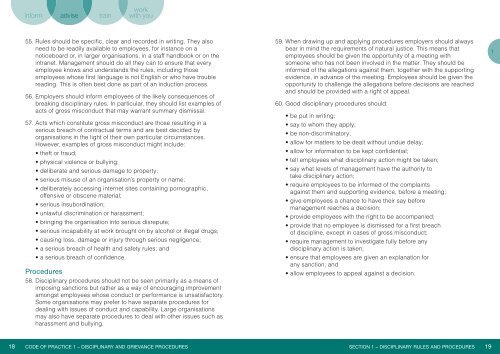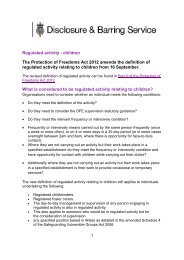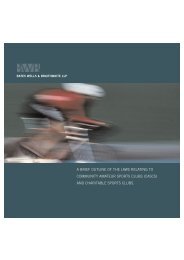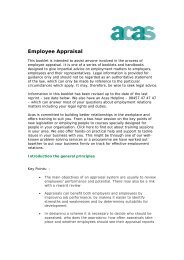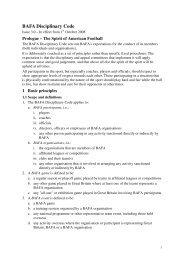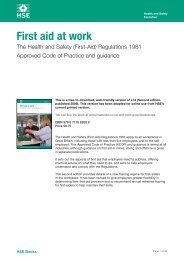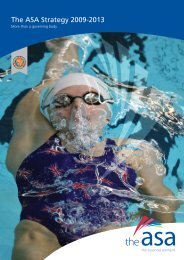Disciplinary & Grievance Procedures - Acas
Disciplinary & Grievance Procedures - Acas
Disciplinary & Grievance Procedures - Acas
You also want an ePaper? Increase the reach of your titles
YUMPU automatically turns print PDFs into web optimized ePapers that Google loves.
55. Rules should be specific, clear and recorded in writing. They alsoneed to be readily available to employees, for instance on anoticeboard or, in larger organisations, in a staff handbook or on theintranet. Management should do all they can to ensure that everyemployee knows and understands the rules, including thoseemployees whose first language is not English or who have troublereading. This is often best done as part of an induction process.56. Employers should inform employees of the likely consequences ofbreaking disciplinary rules. In particular, they should list examples ofacts of gross misconduct that may warrant summary dismissal.57. Acts which constitute gross misconduct are those resulting in aserious breach of contractual terms and are best decided byorganisations in the light of their own particular circumstances.However, examples of gross misconduct might include:• theft or fraud;• physical violence or bullying;• deliberate and serious damage to property;• serious misuse of an organisation’s property or name;• deliberately accessing internet sites containing pornographic,offensive or obscene material;• serious insubordination;• unlawful discrimination or harassment;• bringing the organisation into serious disrepute;• serious incapability at work brought on by alcohol or illegal drugs;• causing loss, damage or injury through serious negligence;• a serious breach of health and safety rules; and• a serious breach of confidence.<strong>Procedures</strong>58. <strong>Disciplinary</strong> procedures should not be seen primarily as a means ofimposing sanctions but rather as a way of encouraging improvementamongst employees whose conduct or performance is unsatisfactory.Some organisations may prefer to have separate procedures fordealing with issues of conduct and capability. Large organisationsmay also have separate procedures to deal with other issues such asharassment and bullying.59. When drawing up and applying procedures employers should alwaysbear in mind the requirements of natural justice. This means thatemployees should be given the opportunity of a meeting withsomeone who has not been involved in the matter. They should beinformed of the allegations against them, together with the supportingevidence, in advance of the meeting. Employees should be given theopportunity to challenge the allegations before decisions are reachedand should be provided with a right of appeal.60. Good disciplinary procedures should:• be put in writing;• say to whom they apply;• be non-discriminatory;• allow for matters to be dealt without undue delay;• allow for information to be kept confidential;• tell employees what disciplinary action might be taken;• say what levels of management have the authority totake disciplinary action;• require employees to be informed of the complaintsagainst them and supporting evidence, before a meeting;• give employees a chance to have their say beforemanagement reaches a decision;• provide employees with the right to be accompanied;• provide that no employee is dismissed for a first breachof discipline, except in cases of gross misconduct;• require management to investigate fully before anydisciplinary action is taken;• ensure that employees are given an explanation forany sanction; and• allow employees to appeal against a decision.118 CODE OF PRACTICE 1 – DISCIPLINARY AND GRIEVANCE PROCEDURES SECTION 1 – DISCIPLINARY RULES AND PROCEDURES 19


